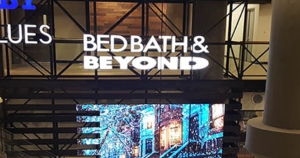One of the fundamental concepts guiding the manufacture of large-format digital displays is the relationship between pixel pitch, viewing distance, and image clarity. To understand how these elements work in concert, the first thing to grasp is the phenomenon of pixelation. As you likely know, a display is not a single, coherent light-producing unit, but rather a collection of hundreds, or thousands, or millions of individual units, known as pixels. As an audience moves closer and closer to a display, eventually they begin to identify these individual pixels as the cohesive image fragments into an array of distinct units. This is called pixelation, and the point at which it happens is a function of how closely spaced a display’s set of pixels are, a metric referenced by the term “pixel pitch.”
Pixel pitch, in the LED industry, refers to the distance between the midpoints of adjacent pixels, and it reveals a remarkable amount of information about a display. The simplest way to think about pixel pitch and its relationship with the distance at which pixelation occurs is that the wider the pixel pitch (and thus the farther spaced out the pixels are), the farther away pixilation will occur. This is why the pixels of a jumbotron are much farther away from each other than the pixels of a wayfinding display. A wayfinding display is designed for audiences only a few feet away, and thus the pixels must be densely packed so that the display image is cohesive at close range. A jumbotron on the other hand is designed for audiences hundreds of feet away, therefore eliminating the need for a narrow pixel pitch. To preempt your question, yes, a jumbotron could use a narrow pixel pitch and accomplish its same purpose, but this would be wasteful since pricing typically increases as pixel pitch shrinks, and a wide pixel pitch jumbotron display gets the job done just fine.
There is no formal equation for how pixel pitch and optimal viewing distance relate to each other, but a general rule of thumb is that pixilation will occur at roughly three times the distance in feet as the pixel pitch is in millimeters. So, to recycle our example from earlier, let’s calculate what an appropriate pixel pitch might be for both a concourse wayfinding display and a huge jumbotron. Say the expected viewing distances for a wayfinding display and a jumbotron are 24’, and 600’, respectively. That would mean an appropriate pixel pitch for each would be 6mm and 200mm, again respectively. Nanolumens specializes in narrow pixel pitch displays, so we would be able to provide those wayfinding display solutions with ease, but jumbotrons are not really within our wheelhouse.
An LED display exists to make an impression. To do so, it’s vital that audiences receive your messaging in clear, uninterrupted fashion so they walk away only remembering your content. As you now can see, this means you have to understand the dynamic between pixel pitch, viewing distance, and image clarity. A solid grasp on these concepts will help you arrive at a display solution with dimensions and specifications that work best for your business. To learn more about pixel pitch, dive into our downloadable white paper, Pixel Pitch: What Is It? Why Does It Matter?

